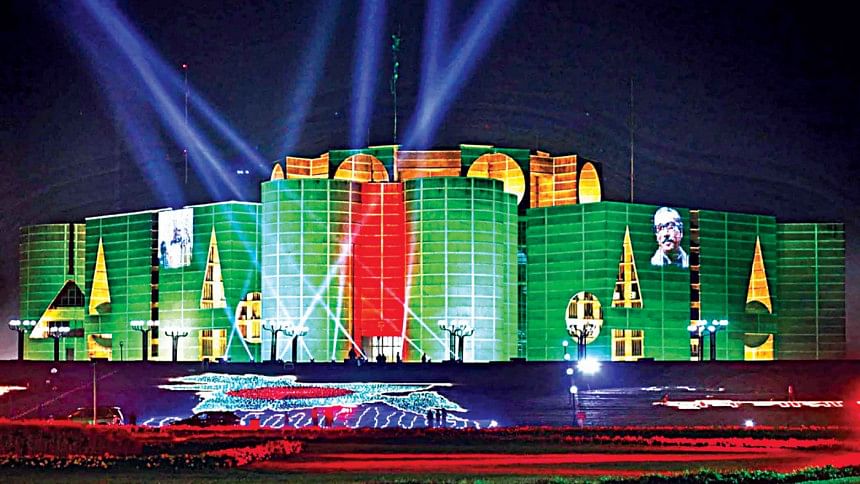Demystifying the “Development Miracle”

Bangladesh's achievements are exemplary for many developing nations, including Pakistan. The main credit lies with the visionary leader, Bangabandhu, who firmly believed that we could do better independently. We did better than Pakistan in most economic indicators and outperformed India in some important aspects of social indicators. How did they happen? Was it really a miracle – a term or rhetoric often used by politicians without understanding its economic underpinnings? In reality, they are the results of farsighted public policies, most of which were laid out by Bangabandhu's vision of "Sonar Bangla."
As Bangladesh celebrates its fifty years of independence, some political rhetoric is resorting to a myth that the country has discovered a magical path of development. However, nothing has happened to term the country's progress as a miracle. It's really a story of farsighted public policies – mainly adopted after independence, economic liberalisation, and democratic continuity of recent decades – which jointly contributed to developmental vibrancy in the country.
Bangladesh achieved more than five percent growth in the last twenty years along with a remarkable rise in per capita income, exceeding Pakistan's and reaching closer to India. Its scores in social indicators, women empowerment, poverty reduction, population control, and the pace in literacy programmes are the outcomes of provident public policies.
Bangladesh earned its independence in 1971 under the heroic leadership of Bangabandhu Sheikh Mujibur Rahman, who also ruled the country for almost four years until he was assassinated in August, 1975. It was a devastated country ravaged by the Pakistani army, and hence Sheikh Mujib's number one challenge was to feed the people of a densely populated country. Almost broken, the infrastructure required a quick fix. The food crisis was rearing its ugly head amid prices spiralling up since 1973 when the advanced countries entered the fire of the Great Inflation.
Unlucky was the first regime, as a famine surfaced in 1974, and convinced the government to seriously continue with three vital policies at a time: population control through a full-scale campaign and social awareness, food sufficiency through agricultural research and development, and free-of-cost universal primary education by devoting public resources in every corner of the country. These fundamentally robust policies empowered the poor and women in particular. Cultural liberalism, which Bangabandhu and his colleagues cultivated since the 1950s, freed women from the cult of Pakistani conservatism. They came out to attend schools and participate in social activism. Today's score of women empowerment owes to that spirit that comes under pressure from fanatic corners at times.
Despite political intolerance between different regimes since 1975, none of the rulers in the post-Mujib era deviated from these policies. The global political reality and Bangladesh's dependence on the capitalist world expedited the country's move to an economy of private enterprises since the mid-1970s. The policies of denationalisation, privatisation, and economic openness – which followed later in the post-Mujib regimes, contributed to a rising influence of the market economy, raising budgetary capacity in the public sector and employment generation in private businesses.
The country witnessed high growth volatility in the 1970s, which is typical for a new-born country with policy switches. As per the World Bank data, the average growth during that preparatory decade from 1973 was four percent. Growth sagged to almost three percent in the 1980s. However, the 1990s, along with liberalisation, witnessed an average growth close to five percent, the 2000s nearly six percent, and close to seven percent in the 2010s. The country experienced growth-led development and a hike in per capita income.
Rural Bangladesh was integrated more effectively with urban developments. Both female literacy and women's labour force participation trended up. Public policies favoured women to get into education and employment. Bangladesh's female force made competent use of these opportunities, reduced unplanned births, embraced all walks of education, and challenged any kinds of jobs. They are the heroes of the "miracle."
Population control was the most successful public policy Bangladesh ever had. The Mujib regime realised that the whole nation would sink into a disaster unless population growth, which was above three percent then, was pulled down. The country now enjoys almost one percent population growth, less than that of both India and Pakistan. The inception of liberalisation since the early 1990s marked the start of a new era, not only in reducing the financial haemorrhage of public enterprises but also ushering in a new horizon of privatisation and employment generation. The pace of privatisation never slowed down since then. Rather, since the mid-1990s, the economic openness, modernisation, and mushrooming of businesses accelerated at the beginning of each new regime regardless of parties. This is the hidden strength of Bangladesh's policy continuity.
The Awami League regime since the end of the 2000s thrived on four things: agricultural development, controlled population, demographic dividend, and women empowerment. The other facet of the demographic dividend spreads over growing consumption, modern tastes, demand for digitisation, increased migration and remittances. The rapid rise of the garments industry since the 1980s contributed to a solid foundation of export earnings, which, being coupled with labour migration and remittances, gave the country a healthy reserve of foreign currencies. Imports went up not only for consumption but mainly to provide raw materials, intermediate goods, and capital machinery – which eventually added booster doses to growth and public revenue. The banking sector played a pivotal role in this regard, even though the capital market and fiscal capability have remained anaemic.
Bangladesh's main weakness is immature institutions which are often plagued with inefficiency and corruption. The slow-to-act bureaucracy, tardy judiciary, disproportionate law enforcement, anarchic transport sector, improper construction work, poor tax collection, quality-deficient education, and an utter disregard to the environment are the challenges the country is confronting increasingly. The focus should be on these aspects now.
While improvements are there, the speed of implementation is somewhat frustrating. The same can be said for many mega infrastructure projects, which, once completed, are supposed to change the functioning and features of the country. Bangladesh has entered a new era after graduating to a middle-income country. The current regime's signature infrastructural commitments are designed to transform the country into a model of development in twenty years.
Bangladesh's story is impressive in that many politicians and economists thought the country would be a paradigm of poverty in the wake of the devastating independence war against Pakistan. Bangladesh disproved it. The country's public policies paid off. Much has changed, and more will soon. Its ever-changing landscape now draws the attention of development thinkers. It's not a miracle. It's a success case of visionary public policies – most of whose seeds were sowed in the post-independence era.
Dr Biru Paksha Paul is a Professor of economics at the State University of New York at Cortland. Email: [email protected]

 For all latest news, follow The Daily Star's Google News channel.
For all latest news, follow The Daily Star's Google News channel. 



Comments